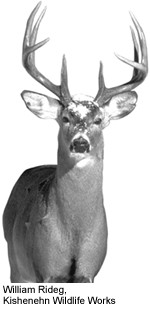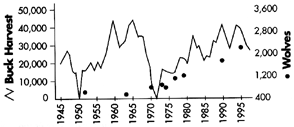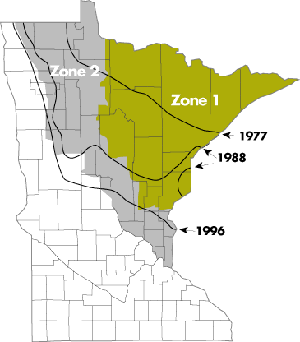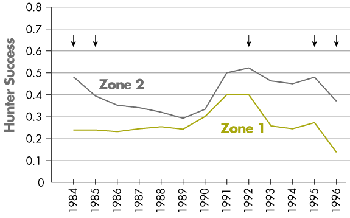No Easy Answers: Effects of Wolf Population Expansion on Deer Hunting in Northern Minnesota
By Bill Route
Editor’s Note: This article originally appeared in the Fall 1998 issue of International Wolf Magazine and is presented here for background information.
 Has the expanding wolf population in northern Minnesota diminished the chance for hunters to harvest white-tailed deer? Available data suggest that on a large scale it has not. Yet in some areas, wolf predation, when combined with severe winter weather and poor deer habitat, has caused declines in deer numbers, which could influence local hunter success.
Has the expanding wolf population in northern Minnesota diminished the chance for hunters to harvest white-tailed deer? Available data suggest that on a large scale it has not. Yet in some areas, wolf predation, when combined with severe winter weather and poor deer habitat, has caused declines in deer numbers, which could influence local hunter success.
In a 14-county area of northeastern Minnesota-the core of the state’s wolf range-the number of bucks harvested between 1945 and 1997 has remained high even in the face of an expanding wolf population. This suggests that wolves have not greatly influenced buck harvest, although this conclusion is confounded by many factors.
Deer harvest is affected by such factors as habitat, weather, the number and type of permits issued, the length of the harvest season, hunter access, and in some cases, predation. But the way deer harvest is managed in the Great Lakes region is largely the product of habitat and winter weather. The dramatic effect of weather on deer harvest is illustrated in figure 1. In both 1950 and 1971, deer hunting seasons were closed due to severe winters; these closures were followed by a fluctuating yet steadily increasing trend in buck harvest. Researchers have noted similar patterns elsewhere in the Great Lakes region, and have shown a well established relationship between severe winter weather and low buck harvest the following year. For example, in Michigan’s Upper Peninsula, an estimated 15,000 deer died during the severe winter of 1971, and that spring an estimated 100,000 fawns failed to survive. This caused years of after-effects on the deer herd. Of course, wolves had nothing to do with this decline because they did not recolonize the Upper Peninsula until 1990-some 20 years later.
Hunter Success in Minnesota
By 1996, wolves in northeastern Minnesota had expanded their range to include most of Minnesota’s Deer Management Zones 1 and 2 (see figure 2). If wolves were having a dramatic effect on deer harvest, one might expect hunter success to drop significantly during this expansion. Yet overall hunter success in harvesting both buck and antlerless deer did not decrease substantially (see figure 3).

Figure 1. Minnesota wolf population (dots) from 1945 to 1997, in relation to hunter harvest of buck deer (trend line) in 14 northern Minnesota counties. The midpoint was used where wolf abundance estimations included a range. Data provided by the Minnesota Department of Natural Resources.
Harvest success did fluctuate, but according to the Minnesota Department of Natural Resources (DNR), this was largely due to changes in the number of antlerless permits issued. The number of permits declined because of severe winter weather (note arrows in figure 3). Wisconsin and Michigan also issue fewer antlerless permits in response to severe winter weather. So again, at least on a large scale, hunter success figures do not indicate that wolves are causing a substantial decrease in deer harvest.
Figure 2. Minnesota wolf range expansion from 1977 through 1996 in relation to Minnesota Deer Management Zones 1 and 2. (Data from the Minnesota Department of Natural Resources)
Seeing the Forest and Not the Trees
Harvest data over a large region, however, may obscure what can occur in smaller areas. For example, from 1968 to 1974, a series of severe winters started a decline in the deer herd in the Superior National Forest of northeastern Minnesota. This severe weather, combined with poor deer habitat and wolf predation, caused the extirpation of a local deer herd. In this case, an intensive study of a 1,200-square-mile area revealed that wolf predation played a role in deepening and prolonging a decline. Yet deer declined throughout northern Minnesota those years, even where wolves were few or nonexistent. Consequently, the Minnesota DNR responded by closing deer hunting state-wide in 1971, and then experimenting with methods to reduce antlerless deer harvest in subsequent years. This new harvest strategy, in combination with mild winters and better deer habitat from logging mature forest, resulted in a 46 percent increase in buck harvest over the 14 counties between 1972 and 1997. It is interesting to note that this increase occurred even as wolves were expanding their range across this area.
Hard Reality
Obviously, wolves kill deer and other prey animals to survive. In the Great Lakes region, researchers note that a wolf eats the average equivalent of about 15 to 20 adult-sized deer per year, which varies depending on the number of alternative prey and winter severity. Usually the carcass of a prey animal is fully utilized by the wolves; however, during the final months of a severe winter with deep snow, wolves sometimes kill more than they need. This “surplus killing seldom occurs, and normally only when deer are nutritionally stressed from deep snow. Researchers have noted that when surplus killing occurs, the internal organs of the deer are often consumed while much of the remaining carcass is left. Normally, wolves start eating the large muscles at the point of attack, but quickly move on to eat the internal organs. The internal organs are probably the most nutritious portions of the animal so that such feeding behavior increases the wolf’s efficiency in acquiring the best food available. During surplus killing, the remaining carcass may appear to be a waste; however, the wolves have taken the best portion and the remains benefit scavengers such as fox, fisher, marten, weasel, bald eagles and ravens. Even wolves will return to feed on the carcass; in nature nothing goes to waste.

Figure 3. Trends in hunter success, from 1984 to 1996, for all deer harvested (bucks and antlerless) in Minnesota Deer Management Zones 1 and 2. Arrows show the years where winter snow depth and cold were considered severe for deer. Data provided by the Minnesota Department of Natural Resources.
Surplus killing occurred during the deer decline in the Superior National Forest. From an ecological perspective, this occasional purging of the deer herd may help rid the herd of less fit animals and may serve to readjust the balance of deer, wolves, and their habitat. Moreover, wolf populations usually decrease from two to five years following the decline of their primary prey.
Long-range Perspective
Given the long-term trends in buck harvest in northern Minnesota- even in the presence of an expanding wolf population-there is little evidence to conclude that wolf predation has greatly hindered the ability of most hunters to harvest white-tailed deer. However, studies have also shown that in some cases wolf predation, in concert with severe weather and poor habitat, has steepened and prolonged local deer declines. The dynamic struggle between wolves and deer is complicated-clearly there are no simple answers.
But even as a deer hunter, I hope never to live where people, politics and the land will not support the survival of wolves. Wolves help make the woods wild. And as for the deer-they are elusive and admirable animals because they have co-evolved with the wolf, an equally keen and well adapted predator.
Much of the information in this article came from the sources below:
Blouch, R. I., “Whitetail Populations and Habitats: Northern Great Lakes States and Ontario Forests, in L. K. Halls, ed., White-tailed Deer: Ecology and Management. Harrisburg, PA: Stackpole Books. 1984. pp. 391-410.
Creed, W. A., F. Haberland, B. E. Kohn, and K. R. McCaffery. “Harvest Management: The Wisconsin Experience, in L. K. Halls, ed., White-tailed Deer: Ecology and Management. Harrisburg, PA: Stackpole Books. 1984. pp. 243-60.
DelGiudice, G. D. “Surplus Killing of White-tailed Deer by Wolves in Northcentral Minnesota. Journal of Mammalogy 79 (1) (1998): pp. 227-35.
Fuller, T. K. “Population Dynamics of Wolves in North-central Minnesota. Wildlife Monographs 105 (1989).
Fuller, T. K. Guidelines for Gray Wolf Management in the Northern Great Lakes Region. International Wolf Center publication No. IWC97-271. 1997.
Kolenosky, G. B. “Wolf Predation on Wintering Deer in East-central Ontario. Journal of Wildlife Management 36 (2) (1972): 357-69.
Mech, L. D. The Wolf: The Ecology and Behavior of an Endangered Species. Garden City, NY: Natural History Press. 1970.
Mech, L. D. and P. D. Karns. “Role of the Wolf in a Deer Decline in the Superior National Forest. Research paper NC-148. USDA Forest Service, North Central Forest Experiment Station. 1977.
Nelson, M. E., and L. D. Mech. “Relationship Between Snow Depth and Gray Wolf Predation on White-tailed Deer. Journal of Wildlife Management 50 (3) (1986): pp. 471-4.
Peterson, R. O., and R. E. Page. “The Rise and Fall of Isle Royale Wolves, 1975-1986. Journal of Mammalogy 69 (1988): pp. 89-99.

